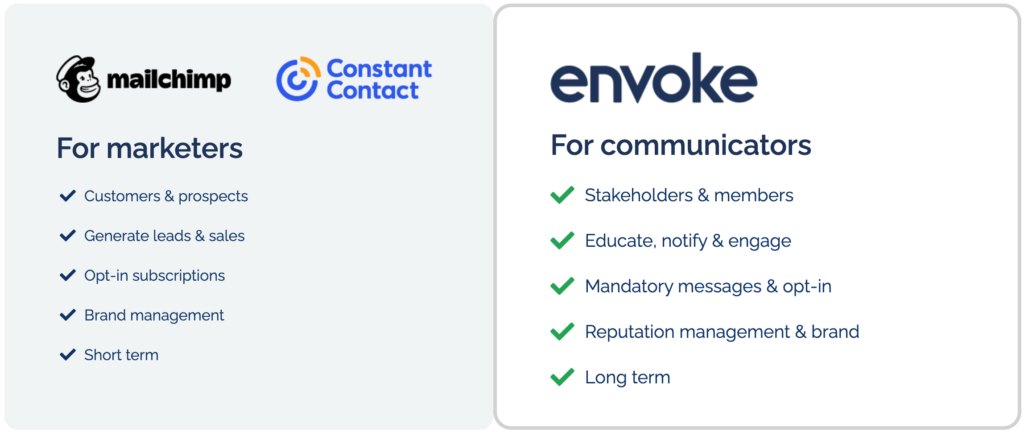When it comes to email marketing vs communications, most people think of the two as interchangeable. While it’s true that they often appear side-by-side in job descriptions and company departments, they also have very distinct purposes and goals, they use different channels, and their success is measured against different outcomes. It’s important that your organization understands the similarities and differences between marketing vs communications, to ensure your employees have the tools they need to succeed.
In this article, we break down the differences between communications and marketing – looking specifically at the function of email in the realm of communications – and provide insight into how they can be integrated to drive organizational success.
Some communicators may be looking for something new and be ready for a free trial of Envoke, a Canadian email marketing software purpose-built for communication – not lead generation. We prioritize data in Canada, offer robust subscription and list management, and uniquely offer the ability to send opt-in or mandatory emails: perfect for organizations who have a legal or contractual obligation to send emails even to recipients who have unsubscribed. Give us a try!
Try Envoke today: Create a free trial account.
Email for communication, not lead generation.
- Includes ALL Envoke features.
- No credit card needed for trial.
- Free, unlimited support.
- Free coaching call with tech support (not sales).
Email Marketing vs Communications: What’s the Difference?
Communication is about exchanging information and driving stakeholder engagement. Core activities include public and media relations, internal communications, and stakeholder and member engagement.
The purpose of communication is to convey a message and build relationships with your audience. Communications can be used to inform, persuade, or educate – it tends to be more focused on longer-term relationship building and brand management.
Content sent by communicators is not always opt-in, it can often be mandatory where a legal or contractual obligation requires that a message be sent regardless of the recipient’s subscription status.
Marketing, on the other hand, is about driving leads and generating interest. The focus is on promoting and selling products or services. It aims to drive demand and ultimately convert it into sales. It’s more transactional by nature and designed to improve ROI.
How communications and marketing goals differ

The primary goal of communications professionals is to build and maintain positive relationships with stakeholders. Stakeholders can include patients, members, constituents, customers, employees, investors, and the general public.
The ultimate aim is to build trust and credibility, enhance reputation, establish a favourable image for the organization, and protect brand equity. This is done through various channels, such as email, social media, internal communications, and public relations.
In marketing, the primary goal is to promote and sell products or services to customers. Marketers tend to focus on understanding customer needs and creating marketing strategies that address those needs. The aim is to increase revenue and profitability by driving customer acquisition, retention, and loyalty. This is done through various channels, such as advertising, promotions, events, and digital marketing.
Integrating communications and marketing
Although we’re discussing email marketing vs communications, there is some overlap and in fact, integrating the two can lead to greater success for your organization.
For example, a pharmaceutical company may have a marketing team that focuses on selling a drug to physicians. The communications team may focus on building relationships with patient advocacy groups, health regulators, and the media to ensure that the company’s reputation remains intact. By working together, communications and marketing can help to build stronger relationships with stakeholders, improve the organization’s reputation, and ultimately drive greater success.
Why you need to understand the difference
Failing to understand where communications and marketing differ can lead to mistakes. Conflating audiences, messages, or channels can have a negative impact on the perception of your organization.
Using the wrong software creates ongoing friction. When communication professionals use marketing software they need to make compromises when it comes to managing subscribers and work with tools that are primarily designed for marketing success.
See How Envoke Compares With Competitors:
- See how Envoke compares to Constant Contact
- See how Envoke compares to Mailchimp
- See how Envoke compares to Cyber Impact
In Canada, it’s also essential to keep data privacy regulations in mind when integrating communications and marketing. Canada has strict data protection laws that organizations must follow when collecting, using, and sharing personal information. By understanding the importance of data privacy and following best practices, organizations can build trust with their stakeholders and avoid any potential legal issues.
About Envoke
Envoke is an intuitive and powerful broadcast email solution that helps Canadian communications professionals build and maintain relationships with stakeholders. The company is an alternative to Constant Contact and Mailchimp in Canada for communications professionals.
With data stored in Canada, full compliance with anti-spam legislation (CASL), and advanced features like mandatory emails and sophisticated list management, you can stop using email marketing solutions and start communicating with Envoke.
